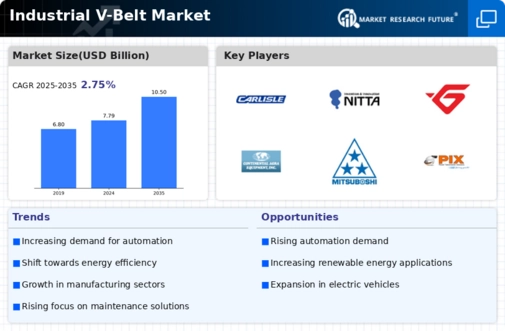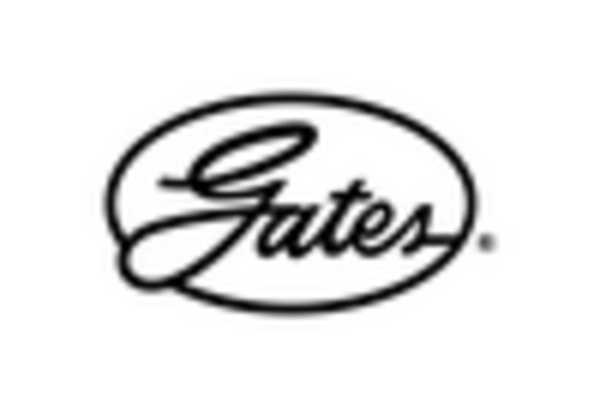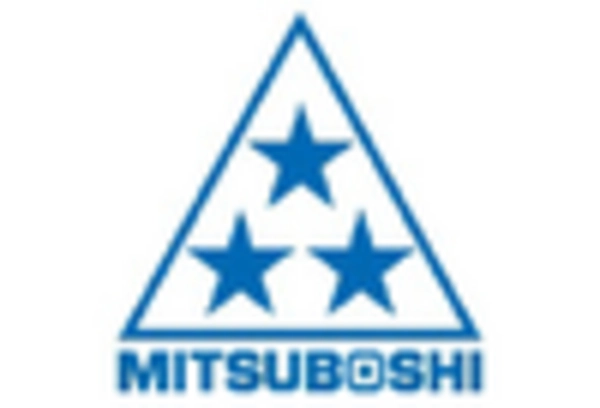Expansion of Manufacturing Sector
The Industrial V-Belt Market is benefiting from the expansion of the manufacturing sector across various regions. As economies recover and grow, there is a marked increase in production activities, which in turn drives the demand for reliable power transmission solutions. The manufacturing sector's growth is projected to contribute significantly to the overall market, with estimates suggesting a compound annual growth rate of around 5% over the next few years. This expansion necessitates the use of durable and efficient V-belts in machinery, thereby enhancing the market's potential. Furthermore, the rise of new manufacturing facilities and the modernization of existing plants are likely to create additional opportunities for the Industrial V-Belt Market, as companies seek to optimize their operations and improve equipment performance.
Growth of Renewable Energy Sector
The Industrial V-Belt Market is also influenced by the growth of the renewable energy sector. As the world shifts towards sustainable energy sources, there is an increasing demand for equipment that supports renewable energy generation, such as wind turbines and solar power systems. V-belts are integral components in many renewable energy applications, facilitating efficient power transmission. The renewable energy sector is projected to grow at a robust pace, with investments in wind and solar energy expected to reach unprecedented levels. This growth presents a significant opportunity for the Industrial V-Belt Market, as manufacturers align their products with the needs of the renewable energy market. The integration of V-belts in renewable energy systems could potentially enhance their performance and reliability, further driving market expansion.
Rising Demand for Energy Efficiency
The Industrial V-Belt Market is experiencing a notable increase in demand for energy-efficient solutions. Industries are increasingly focusing on reducing operational costs and enhancing productivity, which has led to a shift towards energy-efficient machinery. V-belts, known for their ability to transmit power effectively while minimizing energy loss, are becoming essential components in various applications. According to recent data, energy-efficient systems can reduce energy consumption by up to 30%, making them attractive to manufacturers. This trend is likely to drive the adoption of advanced V-belt technologies, as companies seek to comply with stringent energy regulations and sustainability goals. As a result, the Industrial V-Belt Market is poised for growth, with manufacturers innovating to meet the rising demand for energy-efficient products.
Technological Innovations in V-Belt Design
Technological innovations are playing a crucial role in shaping the Industrial V-Belt Market. Recent advancements in materials and manufacturing processes have led to the development of high-performance V-belts that offer enhanced durability and efficiency. For instance, the introduction of synthetic materials has improved the resistance of V-belts to wear and tear, thereby extending their lifespan. Additionally, innovations such as advanced belt profiles and coatings are enhancing the performance of V-belts in various applications. This trend is expected to continue, with manufacturers investing in research and development to create products that meet the evolving needs of industries. As a result, the Industrial V-Belt Market is likely to witness increased competition and a broader range of offerings, catering to diverse customer requirements.
Increased Focus on Maintenance and Reliability
The Industrial V-Belt Market is witnessing an increased focus on maintenance and reliability among industrial operators. As industries strive to minimize downtime and enhance operational efficiency, the importance of reliable power transmission components, such as V-belts, has become paramount. Regular maintenance practices are being adopted to ensure optimal performance and longevity of V-belts, which in turn supports the overall productivity of machinery. Data indicates that unplanned downtime can cost industries significantly, prompting a shift towards preventive maintenance strategies. This trend is likely to bolster the demand for high-quality V-belts that can withstand rigorous operating conditions. Consequently, the Industrial V-Belt Market is expected to grow as manufacturers respond to the need for reliable and durable products that meet the maintenance requirements of various industries.



















Leave a Comment